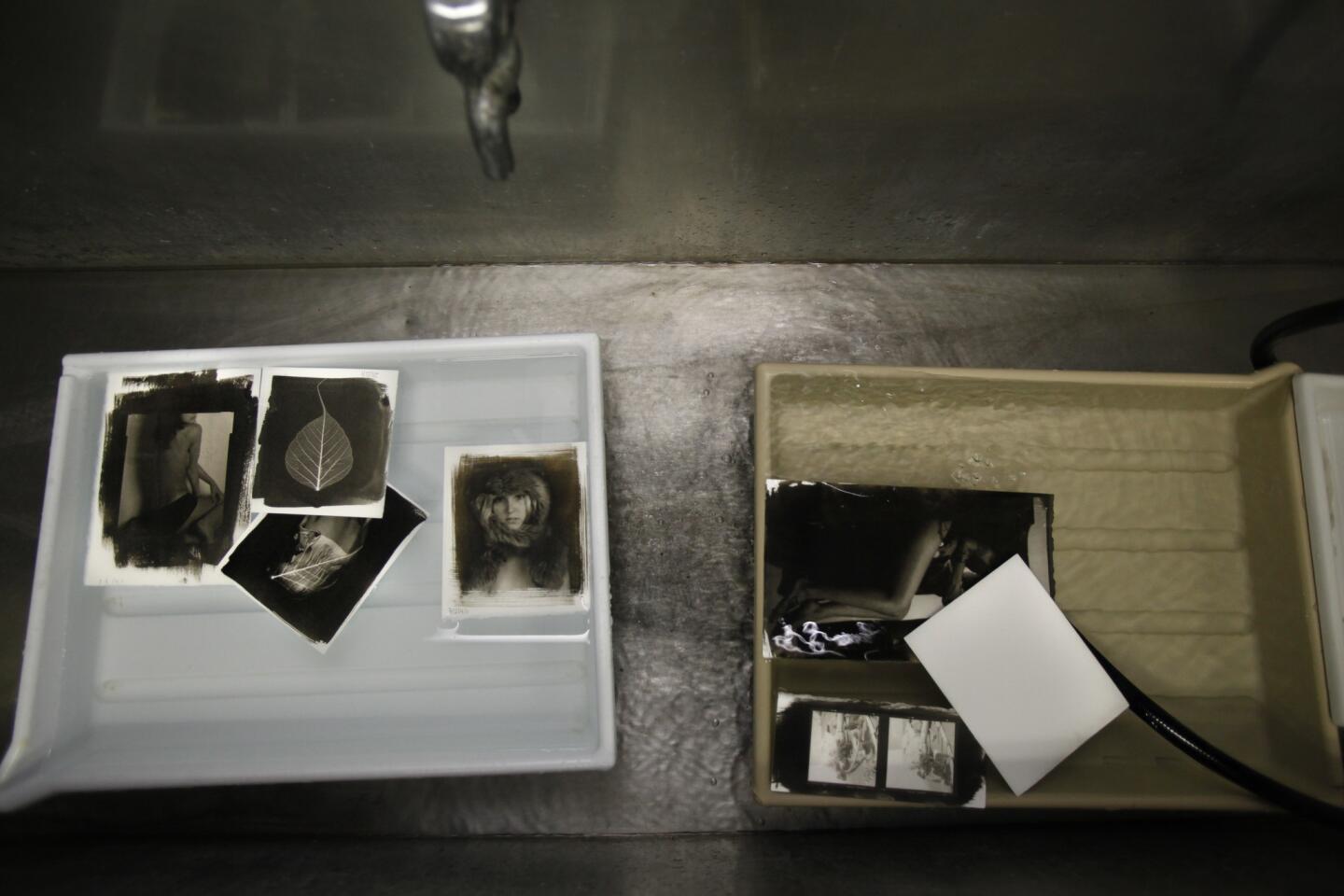Art Center students hone skills with early photo techniques
- Share via
Willie Wenzlau assembled the potential future of the Art Center College of Design’s photography program in front of him one recent afternoon: a leaf he plucked off a tree, a piece of plywood and a shot glass full of an amber liquid resembling Jack Daniels.
His iPhone stayed in his pocket.
“Digital images are inherently less interesting just because everyone does it,” said the 22-year-old photography student. He brushed some of the liquid on the wood, one step in developing photos using platinum, a technique that was last widely used before World War I.
“When someone sees something like this, it’ll hold their attention longer because it catches them off-guard,” Wenzlau said.
Wenzlau is part of the Art Center’s efforts to plan a potential graduate photography degree, in part by taking a step back to the future.
The Pasadena school began offering elective courses in these old-fashioned techniques about two years ago, hoping that students would get a better grasp of photography history while also mastering methods that will help them stand out in a field where everyone with a phone can be a photographer. Students are using boxy Ansel Adams-style cameras mounted on tripods, developing photos with antique processes and spending more time in the film darkroom.
Earlier this year, the school received a $75,000 grant from the Annenberg Foundation to study the ways that the photography and imaging department could change to fit the digital age. Administrators looked backward instead, and found that learning the basics will only help the new photographers. The course electives have been so successful that they plan to incorporate more traditional methods into their graduate courses, which could begin in several years.
“We want to build a graduate program on top of firm foundations,” said Dennis Keeley, the department’s chair.
The Art Center, located near the Rose Bowl, has produced alumni such as film director Zack Snyder and one of the advertisers behind the “Got Milk?” ad campaign, but the majority of undergraduates major in illustration. The four-year school costs undergraduate students about $18,000 per term in tuition, school officials said.
It’s not unusual for art schools to offer classes in antique processes. The Maryland Institute College of Art in Baltimore has long had classes in Van Dyke printing, a process that involves ferric ammonium citrate and tartaric acid, among other old-fashioned methods, said Lynn Silverman, a professor.
“By slowing things down, it gives [students] a behind-the-scenes experience and broadens their minds,” she said.
At the Art Center, platinum enthusiasts say the process has warmer tones than digital black and white images. Many galleries feature platinum during shows, but the method isn’t practical for most working professionals because it is time-consuming and expensive. “It would be very difficult to make a living as a commercial artist” only using platinum, Keeley said.
The class filled quickly. “There are always people who can’t get in,” Keeley said.
On a recent day, a group of 10 students gathered around instructor Norma C. Smith, who has specialized in platinum for nearly two decades. She mixed chemicals in a shot glass using an eyedropper. “It’s not all that dangerous — unless you drink it,” she said.
Smith spread the solution onto paper with a paintbrush, dried it, put a negative on top and then put both into a case with ultraviolet light to bind the image to the paper. Unlike digital prints, which fade in sunlight, platinum images can last forever because they are metal-based.
As Smith put the seemingly blank paper into a tray of developer, an image of a house in a field emerged. “The blacks are so much richer,” one student said admiringly.
The undergraduates began producing their own work, brushing the platinum mixture onto paper or even wood. Smith had suggested they print nude portraits because platinum brings a warm glow to skin, but some of the students opted for more abstract subjects. A man beside Wenzlau printed a leaf while another used a photo of sand circles.
“This is not a common medium, so why take a common picture?” asked Joshue Molina, a third-year student.
Not everyone was pleased with their first effort and asked Smith for advice. “It’s not developing,” one student said as he peered at his wood print.
“Oh, that’s a coating problem,” said Smith, who explained that the image on thick plywood needed longer to emerge. “Keep on going, it’ll come in.”
By the end of the three-hour class, most students said they were feeling better about their skills.
The first two times Miranda Lorenz tried to process her photo of a topless female, the images were too dark. But the third time, she said, she was happier with the finished product. “You can see all of the highlights,” Lorenz said as she washed the picture. “There’s an added dimension and softness.”
The second-year student said she had previously printed the images digitally. “I’d gotten used to them, but this makes me feel like the image is unique again,” she said.
More to Read
Sign up for Essential California
The most important California stories and recommendations in your inbox every morning.
You may occasionally receive promotional content from the Los Angeles Times.




















![Vista, California-Apri 2, 2025-Hours after undergoing dental surgery a 9-year-old girl was found unresponsive in her home, officials are investigating what caused her death. On March 18, Silvanna Moreno was placed under anesthesia for a dental surgery at Dreamtime Dentistry, a dental facility that "strive[s] to be the premier office for sedation dentistry in Vitsa, CA. (Google Maps)](https://ca-times.brightspotcdn.com/dims4/default/07a58b2/2147483647/strip/true/crop/2016x1344+29+0/resize/840x560!/quality/75/?url=https%3A%2F%2Fcalifornia-times-brightspot.s3.amazonaws.com%2F78%2Ffd%2F9bbf9b62489fa209f9c67df2e472%2Fla-me-dreamtime-dentist-01.jpg)